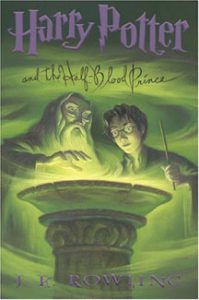For the 20th anniversary of “Harry Potter,” I’m looking back at the books and films of J.K. Rowling’s Wizarding World saga.
“Harry Potter and the Half-Blood Prince” (2005), the sixth and penultimate book in the saga, is J.K. Rowling’s most confident entry (with one caveat that I’ll get to). Like a symphony conductor, she alters the reader’s mood with smooth shifts in tone. It’s as funny as ever, the romances are simultaneously cute and resonant, Voldemort’s backstory gets fleshed out, Snape’s loyalty is (seemingly) revealed, and it ends on a perfect note of sadness and resolve as Dumbledore dies and Harry is now on the front line of the battle.
The “Potter” books have always been feel-good reads, but “Half-Blood Prince” features one particular exchange that made me laugh out loud. In Chapter 24, “Sectumsempra,” Harry nearly kills Malfoy with a spell. Snape suspects Harry got the spell from the Half-Blood Prince’s potions textbook and Harry tries to pass off Ron’s copy as his own:
“Then why,” asked Snape, “does it have the name ‘Roonil Wazlib’ written inside the front cover?” Harry’s heart missed a beat. “That’s my nickname,” he said.
It’s a short passage, but it illustrates Rowling’s ability to shift mood from the very dark moment of a near manslaughter to Harry’s most hilariously pathetic lie ever, while also calling back to the absurdist humor of Ron’s malfunctioning auto-correcting quill from earlier in the book.
Already established as an imaginative inventor of magical creatures, Rowling successfully invents a metaphorical monster in Harry’s stomach, which springs to life in Chapter 14, “Felix Felicis,” when he stumbles across Ginny snogging Dean in a secret passageway. It perfectly illustrates the way teenagers’ minds and even hearts are separate from the heretofore unknown feelings of attraction. (Some complain that the Harry-Ginny stuff comes out of nowhere, and indeed, I do wish Ginny was more of a major character prior to this, but Harry’s feelings are so well written that I’m totally on board.)
With an equally deft touch, Rowling progresses the Ron-Hermione romance – which has hints of an origin in Book 2, when Ron wants to avenge Hermione being turned to stone, and which springs to life in Book 4, when Ron first notices Hermione is a girl. Hermione plays things closer to the vest, but – being a girl – she sure knows how to choose dates to maximize Ron’s jealousy. Since the books are written from Harry’s perspective (with some exceptions), this automatically becomes amusing. From Chapter 14:
It was not as though he was really surprised … He had an inkling that this might happen sooner or later. But he was not sure how he felt about it. … What if Ron and Hermione started going out together, then split up? Could their friendship survive it? … And what if they didn’t split up? What if they became like Bill and Fleur, and it became excruciatingly embarrassing to be in their presence, so that he was shut out for good?
As noted, there are exceptions to Harry being the point-of-view character. Rowling diverted from that perspective in Chapter 1 of Book 4 and does so again in the first two chapters here, showing that the Minister of Magic and British Prime Minister consult with each other, and that Snape interacts with Death Eaters (this doesn’t clear anything up, as he could still be a double agent). Although as readable as all of Rowling’s prose, neither chapter seems necessary; both could’ve been Pottermore bonuses.

The real mythology-building treats of “Half-Blood Prince” are the Pensieve scenes, which technically are from Harry’s P.O.V. As he observes memories that Dumbledore had collected from people who knew Tom Riddle, Harry learns Voldemort’s backstory. It’s engrossing to watch Riddle encounter his earliest victims, building dark power in the same way Anakin Skywalker does by murdering younglings in “Revenge of the Sith.” It’s presented in less hokey fashion here, because Voldemort isn’t following rote instructions; he is a genuine, self-motivated sociopath.
Among those Pensieve memories, we see Riddle acquire objects that had belonged to former Hogwarts Heads of Houses, and thus the Horcrux saga begins. The idea that Voldemort would split his soul into seven parts (six Horcruxes plus himself) in order to survive his body’s death fits with his character, but I’ve always been uneasy about how Dumbledore susses out this information; this is the only part of “Half-Blood Prince” where Rowling’s storytelling confidence lags.
Basically, Dumbledore just guesses that Voldemort has done this, and then he guesses which objects have been made into Horcruxes. While it comes from well-reasoned logic, these are still Dumbledore’s guesses, and it seems like Rowling wants us to accept them as facts. That’s a narrative cheat.
What’s more, the author introduces the mystery of what happened to Dumbledore’s arm (it’s blackened and shriveled), but doesn’t answer it. And, as preamble to Chapter 26, “The Cave,” Dumbledore has learned of a possible location of a Horcrux. (Arguably, these should’ve been the non-Harry-P.O.V. chapters, rather than what we got.) He turns out to be right – there was a Horcrux in the cave, before someone with the initials R.A.B. removed it – but that doesn’t justify the shaky logic. (Also, everyone figured that R.A.B. was Regulus Black within minutes of the book’s publication. It feels like a Book 2-level mystery.)
Speaking of mysteries, the biggest ongoing head-scratcher is settled in “Half-Blood Prince”: We learn once and for all that Snape is evil when he kills Dumbledore in the dramatic Chapter 27, “The Lightning-Struck Tower,” then runs off with his fellow Death Eaters and Malfoy. (Some will point out that it’s not “once and for all,” because Book 7 will deliver more surprises, but it seems final as of now.)
Perhaps concerned that she had stereotyped Gryffindors as good and Slytherins as evil, Rowling takes a step toward more balance in “Half-Blood Prince” with the (admittedly out-of-nowhere) addition of Cormac McLaggen as a dunderhead Gryffindor and new Potions teacher Horace Slughorn as a fairly decent Slytherin — by which I mean he’s not completely evil, which I appreciate since Pottermore sorted me into Slytherin (despite my mutterings of “Not Slytherin … not Slytherin”). Additionally, Gryffindor graduate Percy Weasley continues to be the only member of Ron’s family who lives up to his last name, as he’s still a Ministry lackey.
“Half-Blood Prince” is less political than “Prisoner of Azkaban” and “Order of the Phoenix,” which dealt directly with state-sanctioned prisoner abuse and schoolchildren abuse, respectively. But it does feature a strong moment when Harry declines new Minister Rufus Scrimgeour’s offer to give Harry some Auror help in exchange for good P.R. for the Ministry. Harry rejects the offer over Christmas break – and does so a second time at Dumbledore’s funeral – and I adore the fact that the Ministry’s wrongful imprisonment of Stan Shunpike (they have locked up a few supposed “Death Eaters” to make the public feel better) is at the crux of his reasoning.
Heading into the final book, Harry is wading into the fight against Voldemort, but at least he’s not wading into the cesspool of politics, too.
P.S. Happy 52nd birthday to J.K. Rowling and happy 37th birthday to Harry Potter!
Movie review: “Half-Blood Prince”
Next book: “Deathly Hallows”

